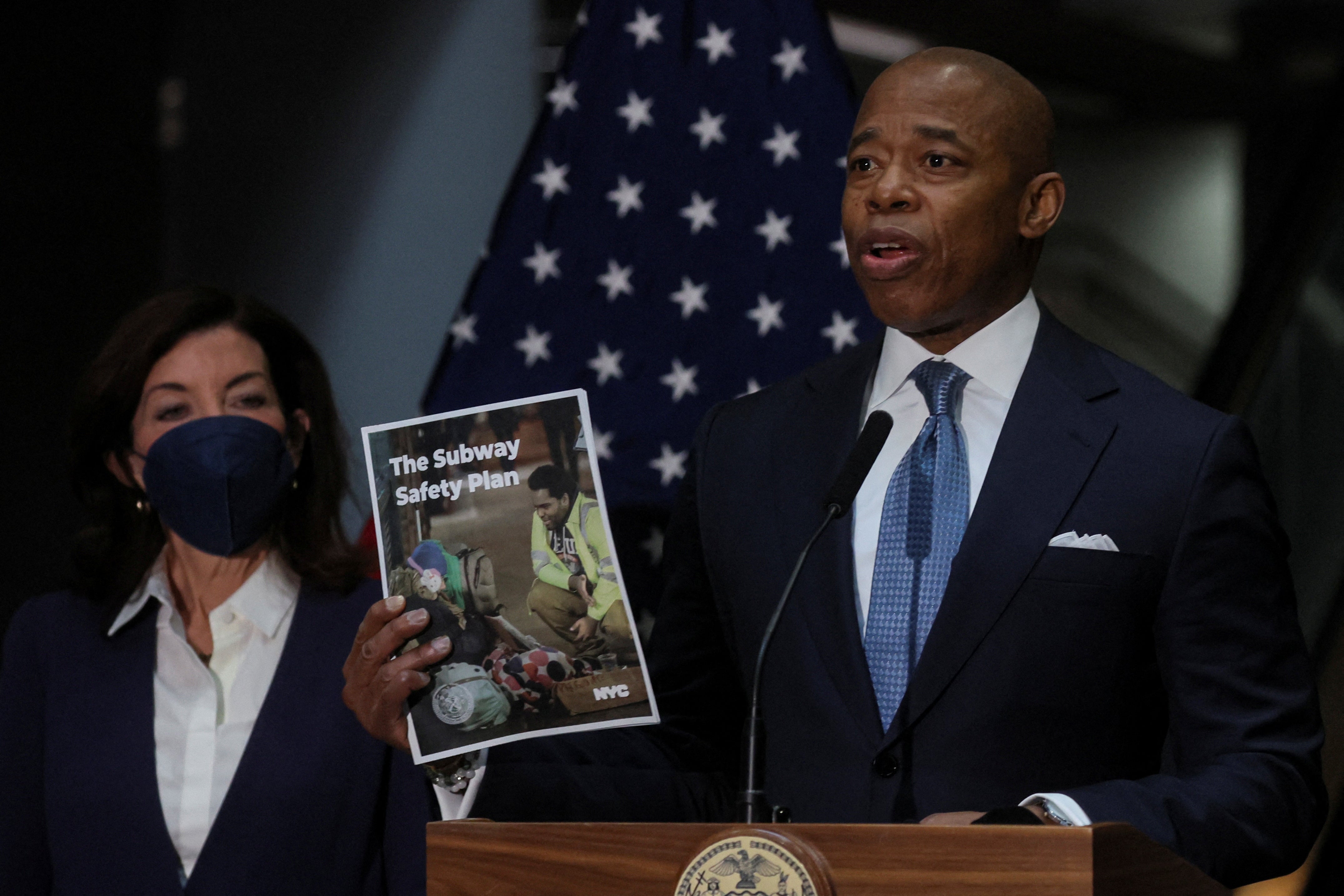NYC advocates condemn mayor’s ‘sickening’ cancer analogy in plan to remove homeless people from subway
Advocacy groups warn against criminalising homelessness as officials announce zero-tolerance plan

New York officials revealed a 17-page enforcement plan to reduce the number of people who rely on New York City subways for shelter and connect people to mental health and substance abuse services.
The plan, following reports of an increase in crime and harassment on the city’s transit lines, gives New York City Police Department officers what Mayor Eric Adams calls a “clear mandate” to enforce the Metropolitan Transportation Authority’s rules, including prohibitions on drug use, littering, lying down on seats and “using the subway system for any purpose other than transportation.”
“You can’t put a Band-Aid on a cancerous sore,” he said on 17 February. “That is not how you solve the problem. You must remove the cancer to start the healing process.”
Homeless advocacy groups have warned against reviving previous “outreach-based” strategies that criminalise behaviour in an effort to reduce the number of people by living on the street without dramatically expanding mental health infrastructure and supportive housing units, which the plan attempts to address.
Shelly Nortz, deputy executive director for policy with Coalition for the Homeless, condemned the mayor’s latest comments.
“It is sickening to hear Mayor Adams liken unsheltered homeless people to a cancer. They are human beings,” she said in a statement. “The mayor’s own police department recently noted that those who shelter in the transit system are there because they believe they have no safer alternative. Criminalizing homelessness and mental illness is not the answer.”
Homeless advocates fear immediate enforcement plans will exacerbate the city’s crisis without equally immediate wider housing and mental health goals, which will take longer to implement pending resources and infrastructure.
Peter Malvan, homeless advocate for the Urban Justice Center’s Safety Net Project, said that “forcing people off the trains into the freezing cold does not help the homeless.”
“Policing does not get people safely housed,” he said in a statement. “The MTA rules that the mayor plans to rely on are unlawful and discriminate against homeless New Yorkers … This approach is wrongheaded, unlawful and is a frightening path to criminalization.”
The plan calls for the creation of new “drop-in centers” following a $100m investment from the state. It also called for 140 “Safe Haven” beds and 350 stabilisation beds, which provide mental health treatment, in 2022.
It also calls for doubling the coverage of Behavioral Health Emergency Deployment teams and will deploy a dozen mental health-focused teams to connect people to services.
Advocates also are concerned about the city’s revival of Kendra’s Law, a state statute that allows courts to force people into psychiatric treatment, which has come under fire for disproportionate impacts among Black people and repeat institutionalisation of people with mental health issues.
“Current statutes provide ample legal authority to transport and involuntarily hospitalize those who endanger themselves or others,” Ms Nortz said. “Expansion of the legal criteria will not solve the problem and could result in pushing people in need further away from care.”
People who reach the end of each subway line will be told they have to leave, and an “End of the Line” team that includes NYPD officers will enforce the policy throughout the transit system, which was recently supported by an additional 1,000 officers.
“People tell me about their fear of using the system, and we are going to ensure that fear is not New York’s reality,” the mayor said. “We all see it, the number of homeless individuals have increased substantially.”
Felony assaults within the subway system were up roughly 25 per cent in 2021 compared with 2019, despite a drop in ridership during the pandemic.
Thirty people were pushed onto the tracks last year, and a series of recent attacks and high-profile subway deaths prompted the new administration to expand police presence in the city’s subways,
Martial Simon – who spent years in and out of mental health care and homeless shelters – allegedly shoved Michelle Go from a Times Square subway platform to her death on 15 January. He was charged with second-degree murder.
Her death heightened scrutiny into reports of violent crime throughout the subway system – which serves millions of daily passengers – and magnified the issue of mental illness and homelessness among hundreds of New Yorkers who rely on that system for shelter.
More than 45,000 people – including 14,600 children – were in city shelters on a given night in 2021, though city data does not include thousands of people who sleep on the streets and in the subways each night.
During his campaign, Mayor Adams – who was inaugurated on 1 January – called for more psychiatric beds and expanded services for people with mental illness, including those who cannot be admitted to a hospital but are unable to return to shelters or the streets.
Join our commenting forum
Join thought-provoking conversations, follow other Independent readers and see their replies
Comments

Bookmark popover
Removed from bookmarks